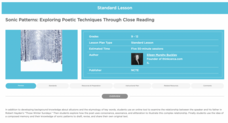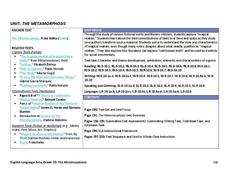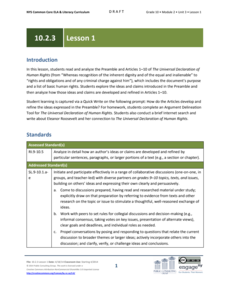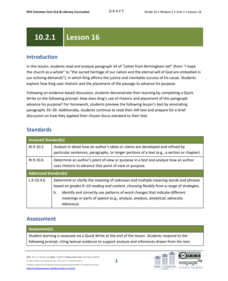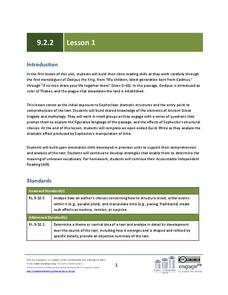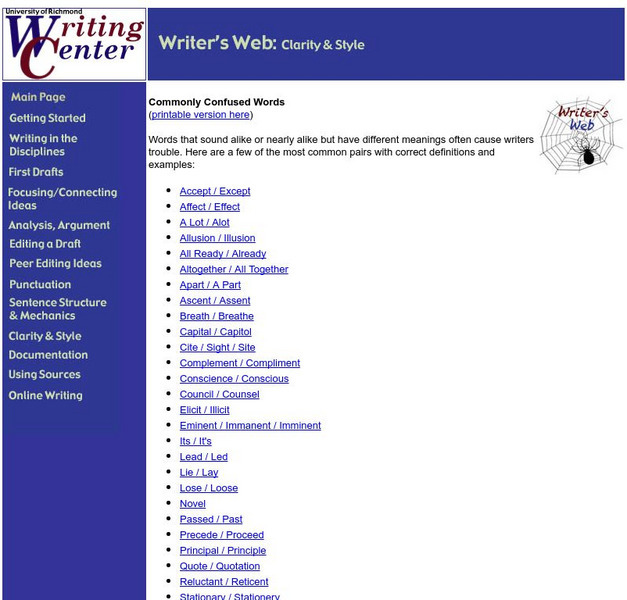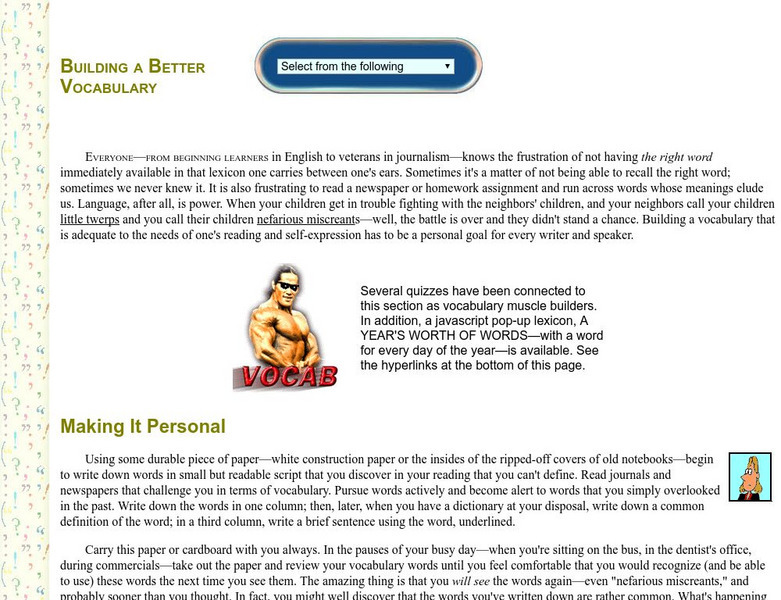ReadWriteThink
Sonic Patterns: Exploring Poetic Techniques Through Close Reading
Robert Hayden's poem "Those Winter Sundays" serves as the anchor text in a five-part lesson that takes the mystery out of poetry analysis by modeling explicit strategies for pupils to employ to conduct a close reading of a poem. After...
Louisiana Department of Education
The Metamorphosis
How can something be true even if it didn't happen? Invite your classes to investigate the truths found in the world of magical realism as they analyze short stories, poems, informational texts, video, and art from this genre.
EngageNY
Grade 10 ELA Module 4: Unit 2, Lesson 9
How does Shakespeare develop the central idea of agency versus fate in Macbeth? Using the resource, pupils work in small groups to discuss the plot of Act 3.1. Next, they complete a brief writing assignment to analyze how the main idea...
EngageNY
Grade 10 ELA Module 2: Unit 3, Lesson 1
Scholars examine the Universal Declaration of Human Rights and analyze the ideas in the preamble. Readers define new vocabulary words, listen to a Masterful Reading, answer questions in pairs, participate in a jigsaw discussion, and...
EngageNY
Grade 10 ELA Module 2: Unit 2, Lesson 2
What is a megalomaniac? Scholars discover the word's meaning as they read and analyze paragraphs seven and eight from Julia Alvarez's essay "A Genetics of Justice." They also read Mark Memmott's article "Remembering to Never Forget" and...
EngageNY
Grade 10 ELA Module 2: Unit 1, Lesson 19
Great minds think alike. Scholars read two texts and compare how the authors develop the same central idea. Readers analyze "Women" by Alice Walker and "Letter from Birmingham Jail" by Martin Luther King Jr. They discuss word use and new...
EngageNY
Grade 10 ELA Module 2: Unit 1, Lesson 15
Some things are worth doing again. Scholars take a look to see which ideas Martin Luther King Jr. revisits and refines in his "Letter from Birmingham Jail." To help with the process, readers answer guided questions, look at word...
EngageNY
Grade 10 ELA Module 2: Unit 1, Lesson 16
Take your place in the world—or the text. Scholars look at how the placement of a particular paragraph adds to the meaning of "Letter from Birmingham Jail" by Martin Luther King Jr. Before working on a quick write activity; readers...
ReadWriteThink
Analyzing Famous Speeches as Arguments
A speaker, a message, an audience. After analyzing these elements in Queen Elizabeth's speech to the troops at Tilbury, groups analyze how other speakers use an awareness of events, and their audience to craft their arguments....
EngageNY
Grade 9 ELA Module 4, Unit 1, Lesson 21
Class members read the chapter, "Serfs and Sweetness" from Sugar Changed the World, and identify the central idea that the development of beet sugar and modern farming technology changed the reliance on the plantation system and made...
EngageNY
Grade 9 ELA Module 4, Unit 1, Lesson 4
Class members continue examining how writers develop and support their ideas by comparing two texts about globalization. Alongside chapters from Sugar Changed the World, young scholars read an article by the World Bank entitled...
EngageNY
Grade 9 ELA Module 2, Unit 2, Lesson 18
The punishment must fit the crime, even for a king. Sophocles' Oedipus the King meets its grisly end with a lesson that focuses on the conclusion of the play and Oedipus' self-assigned punishment. Learners connect the symbolism of his...
EngageNY
Grade 9 ELA Module 2, Unit 2, Lesson 14
The devil—and the truth—is in the details. As ninth graders approach the ending of Sophocles' Oedipus the King, they analyze the words of the Messenger and apply these details to the central ideas of fate and prophecy.
EngageNY
Grade 9 ELA Module 2, Unit 2, Lesson 1
Delve into the heart of dramatic dialogue with a unit focused on Oedipus the King by Sophocles. Having completed an online exploration about ancient Greece beforehand, ninth graders read the play's opening lines and analyze how...
EngageNY
Grade 9 ELA Module 1, Unit 1, Lesson 12
Finding the central idea in a text can be as simple as deciphering the correct pieces of supporting evidence. As your class reads Stage 4 of "St. Lucy's Home for Girls Raised by Wolves" by Karen Russell, they analyze the interactions...
EngageNY
Grade 9 ELA Module 1, Unit 1, Lesson 9
Find the central idea in an excerpt from Karen Russell's "St. Lucy's Home for Girls Raised by Wolves" with a literary analysis lesson. As your class analyzes a section of the story, they determine how the author forms the central idea...
Curated OER
Roots and Affixes: How Words are Created
Designed for a high school audience, this presentation covers roots and affixes in order to build vocabulary. Common prefixes (like bi-, anti-, and dis-) and suffixes (like -al, -ion, and -ous) are briefly introduced. Then, a few slides...
Capital Community College Foundation
Guide to Grammar and Writing: Principles of Composition
If you are a teacher OR a student looking for a well-informed website on elements of the writing process, you are in luck! This site from the Capital Community College is very comprehensive and easy-to-navigate. From grammar basics to...
Capital Community College Foundation
Guide to Grammar and Writing: Parts of Speech
In this exercise, students are asked to identify the underlined parts of speech used in the sentence or to identify the full tense classification of the sentence from five options given. Feedback is given when answer is selected....
Capital Community College Foundation
Guide to Grammar and Writing: A Quiz in Identifying Tenses
In this 10 question quiz, students match names of English tenses in one column with sentences that contain those verb tenses (written in all capital letters) in another column by typing the number of the sentence in the boxes provided.
Georgia Department of Education
Ga Virtual Learning: Verb Tense Handout [Pdf]
This is a four-page "Verb Tense" handout from Nesbitt - Johnston Writing Center, Hamilton College, Clinton, NY, which focuses on the proper tenses to use when writing about literature and when writing about science. I explains present,...
University of Richmond
University of Richmond Writing Center: Commonly Confused Words
A comparison of commonly misused words in the English Language. Words are paired next to one another with their definitions as well as examples of each.
Capital Community College Foundation
Guide to Grammar and Writing: Building a Better Vocabulary
This is an index of vocabulary-building information and quizzes, including a list of roots, prefixes, and suffixes with their meanings. It offers 365 SAT and GRE level vocabulary words, definitions, and sample sentences. The quizzes...
Georgia Department of Education
Ga Virtual Learning: Ninth Literature and Composition: Types of Writing: Review
This lesson is a review of the unit on types of writing including purpose, audience, tone, the writing process, the four types of writing, and sentence fragments and run-ons. A quiz is provided.


